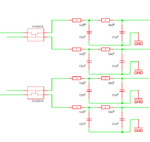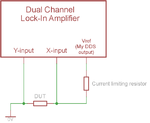KlausST
Advanced Member level 7

Hi,
to get the information about the complex impedance of the load you need to simultaneously sample "voltage" and "current".
How many samples: Nyquist says at least twice the signal frequency. I recommend at least 4 samples per period. With 10MHz this means 40 Msamples/second. (are you able to do this?)
******
As i wrote before a lock in amplifier is far more simple. I used simple analog switches. then some Rs and Cs as low pass filters. The ADC can be very slow, because it simply has do measure about DC.
******
Anyway 10MHz is not that simple. Not with high speed ADC, nor with lock in amplifier. Expect a lot of error. In either case it needs a lot of experience to find the errors and cancel/calibrate them.
Klaus
to get the information about the complex impedance of the load you need to simultaneously sample "voltage" and "current".
How many samples: Nyquist says at least twice the signal frequency. I recommend at least 4 samples per period. With 10MHz this means 40 Msamples/second. (are you able to do this?)
******
As i wrote before a lock in amplifier is far more simple. I used simple analog switches. then some Rs and Cs as low pass filters. The ADC can be very slow, because it simply has do measure about DC.
******
Anyway 10MHz is not that simple. Not with high speed ADC, nor with lock in amplifier. Expect a lot of error. In either case it needs a lot of experience to find the errors and cancel/calibrate them.
Klaus







